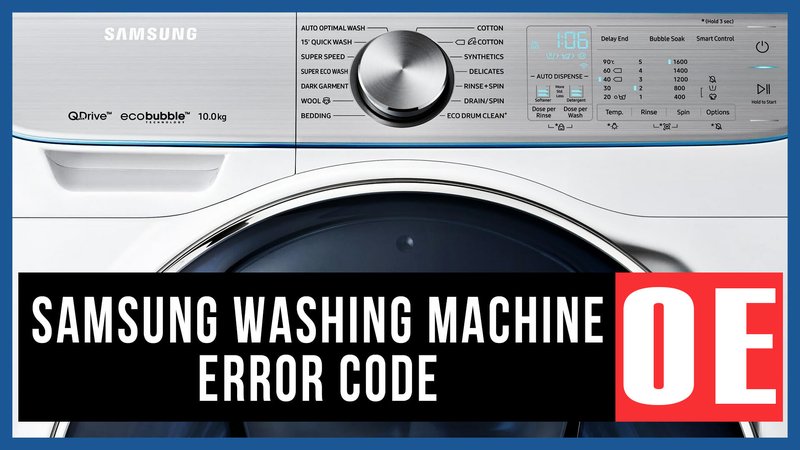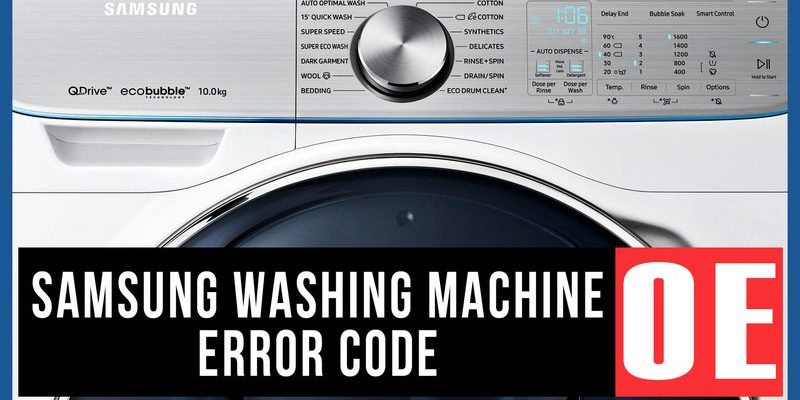
In simple terms, the OE error code is a signal from your Samsung washer that it’s having trouble draining the water. Imagine trying to empty a bathtub with a clogged drain—no matter how much water you try to let out, it just won’t budge. That’s what your washing machine is feeling when it displays this code. It’s a gentle way for your appliance to say, “Hey, I need a little help here with draining!” So, let’s explore why this might be happening and what you can do about it.
Understanding the Drain Hose Issue
The drain hose is like the exit door for the water in your washing machine. If this “door” gets blocked or kinked, the water can’t flow out freely. You might be thinking of it as a garden hose—when working perfectly, water flows out effortlessly, but if it’s bent or clogged, water will trickle out slowly or not at all. This is one of the simple but common causes of the OE error.
Sometimes, the hose can get obstructed with lint or other debris, especially if your washer is in a place with dust or lint circulating around. This buildup can create a barrier just like leaves blocking a gutter. You can prevent this from happening by regularly checking and cleaning out the hose. If your garden hose at home needs checking every season, think of this as a similar routine for your washing machine.
Moreover, ensure that the hose is positioned correctly. Sometimes it could be too low or too high, or even kinked in such a way that gravity and water flow aren’t working in tandem. Adjusting it to a more favorable position can resolve the issue without requiring an expert intervention. Next time you encounter this error, start by peeking at the hose—it’s an easy DIY check that could save you a lot of hassle.
Inspecting the Drain Pump
So, we’ve covered the drain hose. But what if the problem lies within the drain pump itself? Think of the pump as the heart of the washer’s draining system. Just like your heart pumps blood, the drain pump pushes water out. If this component fails, your washing machine won’t be able to get rid of the water, leading to the dreaded OE error code.
The drain pump can sometimes get blocked by items left in pockets. Coins, hairpins, or even a small sock can sneak into places they shouldn’t be. It’s like when something gets stuck in your shoe, causing an uncomfortable walk—it might not be obvious at first, but it sure needs fixing. To check this, you might want to refer to the user manual for steps on how to access the pump, or if you’re not comfortable doing so, calling in a professional could be a wise choice.
Here’s a tip: regularly empty those pockets before tossing clothes in the wash to prevent objects from getting lodged inside your washing machine. Not only will this save you from drainage problems, but it’ll also protect your machine from other potential damage. Remember, a well-maintained washer is a happy washer!
Dealing with Clogged Filters
We’ve all experienced a clogged coffee filter that slows everything down. Your washing machine’s filter can experience something similar. Clogs can build up over time due to lint, fabric softener residues, and other tiny particles that escape during washing. When this filter gets blocked, it obstructs the water flow, which can cause the OE error code to appear.
Cleaning the filter is akin to cleaning out your vacuum cleaner’s filter. It’s a routine task that ensures everything runs smoothly. Access the filter—usually found at the bottom front of your washer—and give it a thorough clean. If it’s your first time, consult the manual for guidance, much like you would when changing your vacuum filter for the first time. This simple maintenance step can often prevent problems before they start.
Another useful tip is to run an empty cycle with hot water and a bit of vinegar every few months. This helps to break down any soap buildup and keeps the internal workings of your washing machine spick and span. It’s like giving your washer a spa day, which in turn, keeps it running efficiently and reduces pesky error codes.
When Professional Help Is Needed
Sometimes, even after checking the hose, pump, and filter, the OE error code persists. It could be due to issues within the internal wiring or other components beyond a beginner’s troubleshooting skills. Much like when your car’s check engine light won’t go off, calling in an expert might be the best route to ensure everything is running smoothly and to avoid additional damage.
Professional technicians have the tools and expertise to diagnose and fix hidden problems. They’ll check the internal circuitry, and other delicate components, and make sure everything’s in order. If you’re feeling out of your depth, there’s no harm in calling in a pro. It’s always better to be safe than sorry!
To avoid future issues, you might consider scheduling regular maintenance checks with a professional. This proactive approach is like having an annual physical check-up to catch any potential issues early. It’s an investment in your machine’s longevity and your peace of mind.
In summary, while the OE error code can be an unexpected nuisance, understanding its causes and taking preventative action can keep your Samsung washer in tip-top shape. Happy washing!
